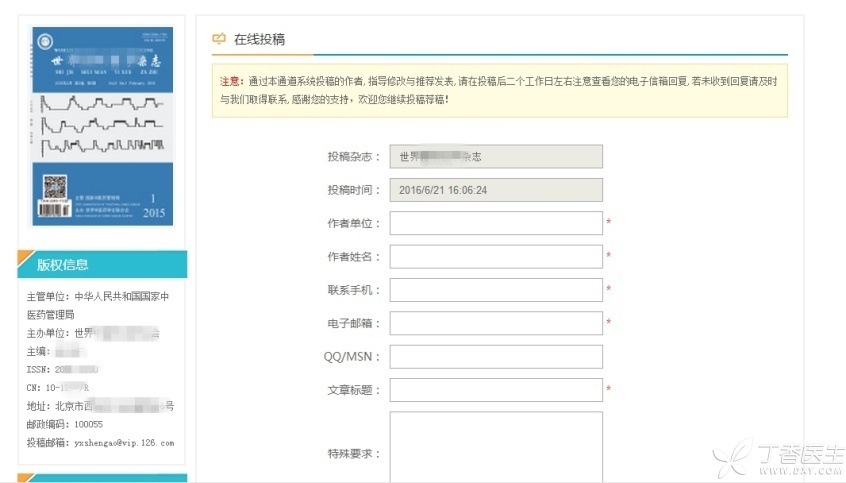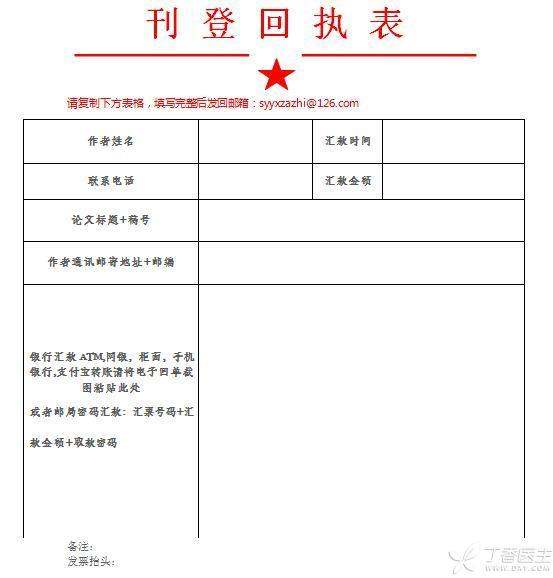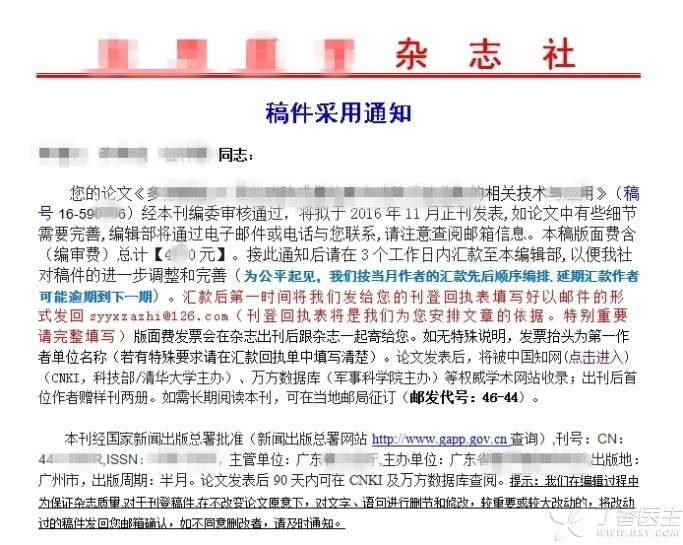Nowadays, it is becoming more and more convenient to search on the Internet, but it is also convenient for some criminals to make money or kill.
Recently, I happened to hear the story of a victim-a [editorial website] and an e-mail, which cheated 4 800 yuan [publishing fee]. Later, it was discovered that there were so many loopholes in front of the victim, but they were turned a blind eye.
Write it down also to remind everyone: cheats are everywhere, and you should be cautious in submitting articles. Everyone around you who needs to do research and send papers should read it again. Tell everyone quickly!
A typical deception experience,
The following is the story told by the victim himself:
In my initial submission selection, I chose < < * * magazine > >, which has a high degree of agreement with my paper. I searched [* * magazine] on the Internet and found a website that looks like an official website. As a result, I started the first step of being cheated.

One week after I completed my online contribution, I received an email from the editorial department. The original content of the email:
Your online contribution to the website < < **** Research Progress > > has been checked. After examination, this contribution is recommended to be submitted to < < *** Medical Magazine > > CN: * */R, ISSN: * *. The contribution has been recommended to the editorial department of < < *** Medical Magazine > > and has been employed. If you agree to publish it, please go through the publication formalities according to the notice of use (see attachment).
When I saw the word [employment], I couldn’t restrain my excitement. It was really smooth.
In fact, at this time, a simple thought will find the problem:
Why did you switch?
Why can we switch directly without the consent of the author?
Why did the preliminary examination and external examination be completed in only 4 days?
In the attachment of the mail, there are also two documents: [Publication Receipt Form] and [Employment Notice].

In this publication form, the contributor is required to fill in the remittance information, which virtually gives me a hint to remit the layout fee quickly. At the same time, the red document header and the red five-pointed star all make people feel that this is a formal document of a formal unit and has nothing to do with cheats.
Perhaps I haven’t sent a paper in the past 4 years, or maybe subconsciously I even think that this receipt form is really some [high-level]. I didn’t think of verifying the mailbox in the form on the Internet, so I was one step closer to being cheated (after verification, the mailbox was fake).
After failing to see through the [publication receipt form] successfully, the [rich content] [manuscript adoption notice] stamped with the official seal was even more dazzling and confusing.

If the notice is especially prominent, it is the contents of these reminders:
Please remit the money to the editorial department within 3 working days after receiving this notice.
For the sake of fairness, we arrange the remittance order of the authors in the current month, and the authors who postpone the remittance may be overdue to the next issue.
Due to the busy work in this department, if you have any questions, please contact us through email as far as possible. We will reply to you as soon as possible after receiving the email. Thank you for your understanding and support!
I went to the bank to remit the money in a muddle-headed way after work that day. I am afraid of postponing my manuscript and hope to finish the process as soon as possible.
Later, everyone should know that after the remittance, the phone was disconnected and there was no reply to the editorial department. I was cheated.
How Prevents Internet Contribution Fraud?
Nowadays, it is not a rare phenomenon that all kinds of information are flooded and supervision is not in place. In terms of periodical contribution alone, if you search for so-and-so magazine on the search engine, you will retrieve a large number of false web pages with information on the magazine’s contribution.
Among them, the top ranking is generally promoted by [gunmen] companies under the bidding mechanism, and then various false websites are used to cheat fees. The real editorial department website is buried in a large amount of spam.
Therefore, at present, most editorial departments will issue [solemn statements] on their official websites or paper magazines, listing known false websites in order to set the record straight. At the same time, you can also follow the following measures to avoid being cheated.
The first move is to understand the general situation of periodicals and the manuscript process.
When locking a target periodical, it is best to find the paper periodical through the library of the school or the unit or retrieve the information and manuscript contract of the periodical through Wanfang and HowNet, so as to determine the contact information and official website of the editorial department. These information can generally be found in the copyright page of the periodical.
The normal manuscript release is like this:
- The total length of preliminary examination and external examination of most periodicals varies from 1 to 3 months. Some editorial departments will charge review fees (different from publishing fees) before external examination. The editorial department will pay this part of the expenses to the reviewer. After the external review is completed, There will be a fee for the publication process of the paper (commonly known as [publishing fee]), However, as mentioned above, there are not many people who set a 3-working-day deadline. The payment order is generally not used as the basis for the arrangement order, and more consideration will be given to the current column setting and manuscript content. Before collecting the publishing fee, the editor will generally send external review opinions to the author, or the author can consult it himself. If necessary, there will also be a link of withdrawal. Whether it can be finally published or not can only be determined after several rounds of communication. Finally, there will be a link of proofreading by the author himself before printing.
The second move: the identification of manuscript employment and publishing fee notice
After the manuscript passes the process of external review and revision, it will enter the process of confirming publication. The editorial department will send the author an employment notice and a notice of publishing fee, which can be separated or combined into one.
The employment notice mainly informs the author of the time and issue number of the manuscript. Some authors need a formal [paper acceptance letter] (or [paper employment letter], etc.), and the editorial department is obliged to provide it and affix its official seal.
The notice of publishing fee mainly informs the author how much the paper needs to be published, the specific payment method and account number, etc. Among them, the most noteworthy is:
Generally, there is only one bank account number in the editorial department, and it is basically a public account number. The account name is * * editorial department, not a person’s name.
In the fake [notice] above, the bank account name is [Zou Zhi], and there are many different bank accounts, which should be alerted. The contact information of the editorial department should also be provided in the notice of publishing fees.
Third trick: Communicate more with the editorial department by telephone,
No matter which editorial department, it is obliged to receive the author’s telephone consultation. As mentioned above, it is directly suggested that the author should not make a phone call, and it is rare to use email to contact.
After submitting articles, everyone should have effective telephone communication with the editorial department, especially when there is a large amount of remittance. At the same time, the landline telephone provided by the editorial department should also be searched and verified.
